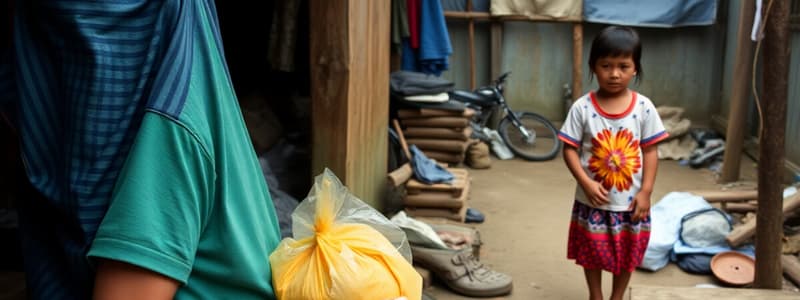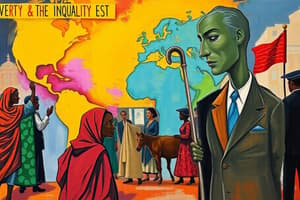Podcast
Questions and Answers
In 2021, the Philippine Statistics Authority reported that approximately 75% of the population lived above the national poverty line.
In 2021, the Philippine Statistics Authority reported that approximately 75% of the population lived above the national poverty line.
True (A)
The proportion of the employed population living below $1.90 purchasing power parity a day in the Philippines was approximately 15% in 2021.
The proportion of the employed population living below $1.90 purchasing power parity a day in the Philippines was approximately 15% in 2021.
False (B)
Factors such as widespread job opportunities, easily accessible education and superior healthcare contribute significantly to widespread poverty and inequality.
Factors such as widespread job opportunities, easily accessible education and superior healthcare contribute significantly to widespread poverty and inequality.
False (B)
Poverty and inequality in the Philippines primarily stem from excessive infrastructure development.
Poverty and inequality in the Philippines primarily stem from excessive infrastructure development.
Poverty and inequality are devastating, affecting aspects of human lives, ranging from quality healthcare and education to child welfare issues.
Poverty and inequality are devastating, affecting aspects of human lives, ranging from quality healthcare and education to child welfare issues.
Children from affluent backgrounds have an equal risk of dropping out of school and engaging in criminal activity compared to children from poor backgrounds.
Children from affluent backgrounds have an equal risk of dropping out of school and engaging in criminal activity compared to children from poor backgrounds.
Poverty-fueled social unrest enhances national stability and promotes economic development.
Poverty-fueled social unrest enhances national stability and promotes economic development.
The Philippine government's Pantawid Pamilyang Pilipino Program (5Ps) aims to enhance poverty alleviation through cultural grants.
The Philippine government's Pantawid Pamilyang Pilipino Program (5Ps) aims to enhance poverty alleviation through cultural grants.
The K-12 Education Program in the Philippines is primarily aimed at expanding access to higher education for underprivileged students.
The K-12 Education Program in the Philippines is primarily aimed at expanding access to higher education for underprivileged students.
Eradicating poverty and inequality in the Philippines requires autonomous action from the government, with minimal need for collective societal involvement.
Eradicating poverty and inequality in the Philippines requires autonomous action from the government, with minimal need for collective societal involvement.
Flashcards
Philippine Poverty
Philippine Poverty
A social issue in the Philippines where a significant portion of the population lives below the national poverty line.
Philippine Inequality
Philippine Inequality
A situation in the Philippines where there's an uneven distribution of wealth and opportunities among its citizens.
Causes of Poverty in the Philippines
Causes of Poverty in the Philippines
Limited jobs, inaccessible education/healthcare, and lack of infrastructure development.
Effects of Poverty and Inequality
Effects of Poverty and Inequality
Signup and view all the flashcards
Government Initiatives in the Philippines
Government Initiatives in the Philippines
Signup and view all the flashcards
Conditional Cash Transfer (CCT) Program
Conditional Cash Transfer (CCT) Program
Signup and view all the flashcards
Pantawid Pamilyang Pilipino Program (4Ps)
Pantawid Pamilyang Pilipino Program (4Ps)
Signup and view all the flashcards
K-12 Education Program
K-12 Education Program
Signup and view all the flashcards
Study Notes
- Poverty and inequality are significant social problems in the Philippines.
- 23.7% of the population lived below the national poverty line in 2021.
- 2.8% of the employed population lived below $1.90 purchasing power parity a day.
- Limited job opportunities, inaccessible education and healthcare, and a lack of infrastructure development contribute to poverty and inequality.
- These factors create an inequality gap, making it harder to escape poverty.
- Poverty and inequality lead to malnutrition, poor health, limited education access, and child welfare issues.
- Children from poor backgrounds are more likely to drop out of school and engage in criminal activity.
- Poverty-fueled social unrest threatens national stability and economic development.
- The Philippine government has implemented programs such as the Conditional Cash Transfer (CCT) Program and the K-12 Education Program.
- These programs aim to alleviate poverty through cash grants, expand education access and healthcare, and encourage inclusive economic growth.
- More work to combat poverty and inequality entirely in the Philippines is required.
- Collective action and sustainable strategies are needed to eradicate poverty and inequality.
Studying That Suits You
Use AI to generate personalized quizzes and flashcards to suit your learning preferences.
Description
Poverty and inequality are significant social problems in the Philippines, with many people living below the national poverty line. Factors such as job opportunities, education, healthcare, and infrastructure development contribute to these issues. The Philippine government has implemented programs to alleviate poverty through cash grants, education, and healthcare access.



